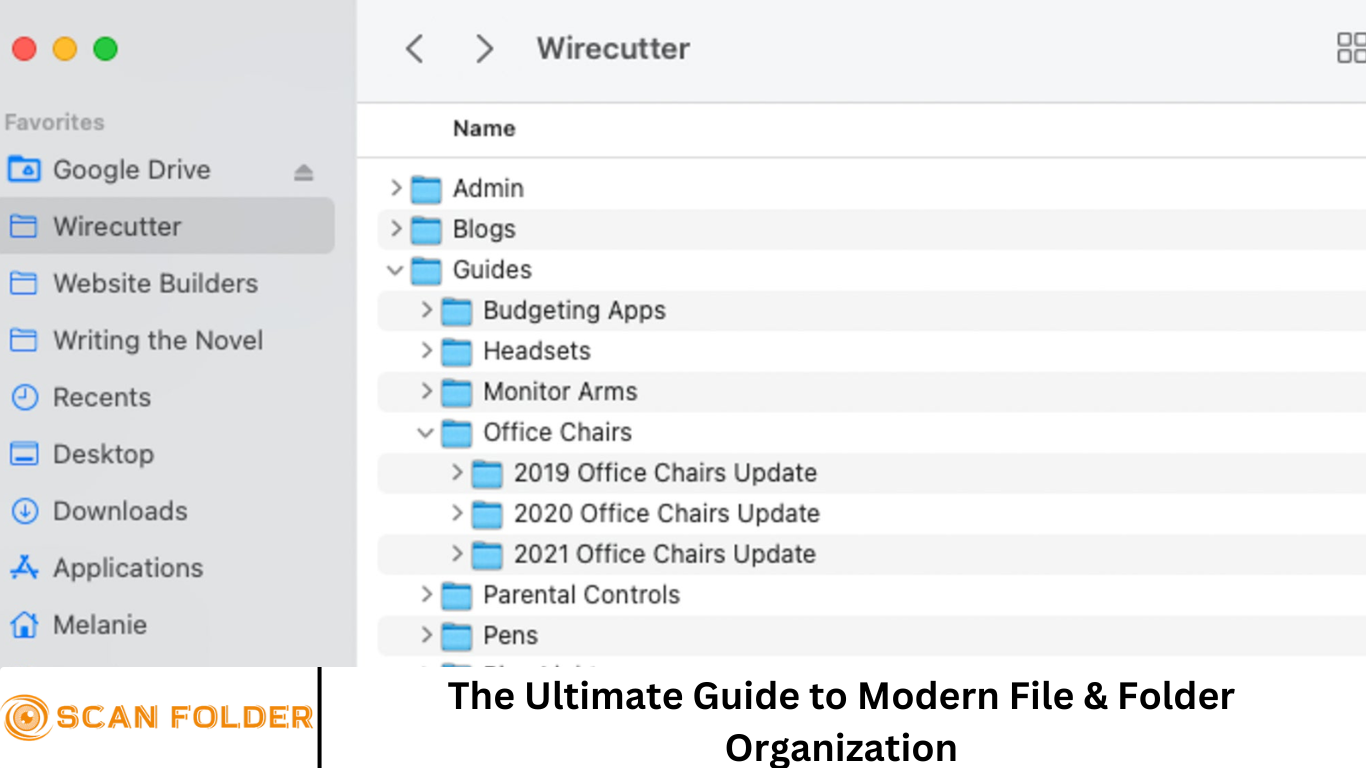Effective file and folder organization is no longer optional—it’s essential. Whether you’re managing personal documents, collaborating within a team, or scaling a business, organizing your digital files efficiently saves time, reduces stress, and increases productivity.
In today’s digital age, where data is scattered across cloud platforms, drives, and devices, knowing how to implement a modern file and folder structure can drastically improve your workflow. This guide will walk you through best practices, modern strategies, and actionable tips for organizing files and folders like a pro.
More Read: 7 Smart Ways to Make File Explorer More Efficient
Why File & Folder Organization Matters
Before we dive into strategies, let’s look at why file organization is so important:
- 🔍 Quick access: No more hunting for files.
- 👥 Team collaboration: Everyone knows where to find and save files.
- 🧠 Mental clarity: A clean digital space equals a clear mind.
- 🔐 Data security: Organized data is easier to protect and back up.
- 🕒 Time efficiency: Less time wasted on locating or duplicating files.
Common File Management Problems
Many individuals and teams suffer from these common file organization issues:
- Randomly named files like
Document1_FINAL_FINAL.docx - Folders within folders within folders
- Duplicate or outdated files
- Inconsistent naming conventions
- Disorganized shared drives or cloud storage
These issues can spiral out of control—especially in fast-paced environments. The solution? A structured, scalable, and modern file organization system.
Principles of Modern File Organization
1. Simplicity Wins
Keep your folder structure shallow and intuitive. Avoid burying files under too many subfolders.
2. Consistency is Key
Whether it’s naming conventions or folder structures, consistency helps everyone stay on the same page.
3. Make it Scalable
Your folder system should grow with your needs. A good test: can someone new understand the structure in under 5 minutes?
4. Use Clear Naming Conventions
Avoid vague names. Use formats like:
YYYY-MM-DD_ProjectNameClientName_Invoice_###Department_Topic_Version
Setting Up a Modern Folder Structure
Here’s how to design a clean, organized, and scalable folder hierarchy.
Step 1: Define Top-Level Categories
These are your broadest buckets. For a business, examples might include:
01_Clients02_Projects03_Operations04_Marketing05_HR
For individuals:
PersonalWorkFinancePhotosEducation
Pro Tip: Prefix folders with numbers (e.g., 01_, 02_) to keep them sorted logically.
Step 2: Create Standard Subfolders
Under each top-level category, create standard subfolders. For example:
swiftCopyEdit/01_Clients/
/ClientA/
/Contracts/
/Invoices/
/Designs/
/ClientB/
Step 3: Use File Naming Best Practices
Examples of good file names:
2025-06-26_ProjectProposal_v1.docxQ2-2025_MarketingPlan_FINAL.pdfJohnDoe_CV_2025.pdf
Avoid:
Doc1.docxLatest_resume.docxCopy (2) of report.docx
Folder Organization by Use Case
📁 For Teams and Businesses
Use a centralized file system on a cloud platform like Google Drive, Dropbox, or OneDrive with shared access and permissions.
- Use clear permissions: View, Edit, Comment.
- Create templates for folder structures per project or client.
- Implement a document retention policy to reduce clutter.
Team Folder Example:
swiftCopyEdit/Projects/
/Website_Redesign/
/01_Research/
/02_Design/
/03_Development/
/04_Assets/
🧑💻 For Freelancers and Creatives
Organize by client or project. Use folders like:
swiftCopyEdit/Clients/
/ClientName_ProjectName/
/Brief/
/Drafts/
/Revisions/
/Final/
Tools like Notion, Trello, or Asana can supplement your file structure by managing tasks and deadlines.
🏠 For Personal Use
Group by life category:
swiftCopyEdit/Finance/
/Taxes/
/Receipts/
/Budgets/
/Home/
/Utilities/
/Repairs/
/Photos/
/2025/
/June/
Best Practices for Digital File Management
1. Use Cloud Storage
Cloud platforms (Google Drive, Dropbox, iCloud, OneDrive) provide version history, sharing, backups, and access across devices.
2. Set File Permissions Properly
Limit access by role. Not everyone needs full edit permissions.
3. Schedule Regular Cleanups
Every month or quarter, clean up outdated or duplicate files. Archive what’s not needed day-to-day.
4. Automate Where Possible
Use tools like Zapier or IFTTT to:
- Auto-save email attachments to folders
- Rename files on upload
- Sort files by type or date
5. Back Up Critical Data
Even with cloud storage, regular backups on external drives or backup services (e.g., Backblaze) are a smart fail-safe.
Recommended Tools for File Organization
Here are top tools to help you stay organized:
✅ Google Drive
- Easy to use, real-time collaboration, powerful search.
✅ Dropbox
- Reliable sync, smart sync for space-saving, good integrations.
✅ OneDrive
- Ideal for Windows users, integrates with Microsoft 365.
✅ Notion / Evernote
- Great for organizing notes, links, and file references.
✅ Search Tools (Everything, Alfred, Spotlight)
- Instantly find files by keyword, date, or tag.
How to Train Your Team in File Organization
Adopting a new structure is half the battle—getting your team on board is the other half.
- Create a File Naming Guide: Document and share naming rules.
- Train New Hires: Include file organization in onboarding.
- Audit Quarterly: Ensure folders are being used correctly.
- Lead by Example: Follow the structure yourself to set a standard.
Advanced Tips for File Organization
🔖 Use Tags & Metadata
On Mac or Windows, tagging files (e.g., “urgent,” “client,” “invoice”) helps you filter quickly, regardless of folder.
🔍 Use Powerful Search Features
Modern systems let you search by:
- File type (
type:pdf) - Date modified
- Keywords inside documents
🧭 Build a File Index
If your structure is very large, maintain an “index” document linking to key folders or files. Especially useful in team drives.
File Organization Template Example
Here’s a sample structure you can adapt:
swiftCopyEdit/Business/
/01_Admin/
/02_Clients/
/ClientA/
/Contracts/
/Invoices/
/ClientB/
/03_Projects/
/ProjectX/
/Briefs/
/Assets/
/Reports/
/04_Marketing/
/Content/
/Ads/
/Designs/
/05_HR/
/Resumes/
/Onboarding/
Use this as a blueprint and modify it based on your team’s needs.
Frequently Asked Question
What is the best way to structure digital folders for a team?
The best way is to use a hierarchical structure with clear top-level folders for categories like Projects, Clients, HR, and Marketing. Under each, create consistent subfolders and use standardized naming conventions. Ensure everyone on the team understands the structure and access levels.
How do I name files to keep everything organized?
Use a clear and consistent naming convention such as:YYYY-MM-DD_ProjectName_Version.ext
Example: 2025-06-26_WebsiteRedesign_v3.pdf
This makes sorting and searching easier and helps avoid confusion.
What tools help with modern file organization?
Popular tools include:
- Google Drive (cloud storage, collaboration)
- Dropbox (syncing, Smart Sync)
- OneDrive (Windows & Office integration)
- Notion or Evernote (notes and linking files)
- Search utilities like Alfred (Mac) or Everything (Windows)
How often should I clean or reorganize my folders?
It’s best to audit your folders quarterly. Remove duplicates, archive old files, and reorganize if structure has broken down. A yearly deep clean is recommended for archiving or deleting obsolete files.
What’s the difference between archiving and deleting files?
Archiving moves files you no longer need regularly but may want later. They’re stored safely in a separate folder or location.
Deleting permanently removes files you no longer need or have backed up elsewhere.
How can I train my team to follow a folder structure?
Create a file organization policy that outlines folder naming, structure, and file conventions. Provide templates, conduct a brief training during onboarding, and review usage regularly to ensure adoption.
What’s the most common mistake in file management?
The most common mistake is inconsistency—in naming, structure, or file placement. Without rules or a shared system, folders become cluttered, files get lost, and productivity drops.
Conclusion
A well-organized file and folder system isn’t just about tidiness—it’s a foundation for efficiency, collaboration, and peace of mind. By adopting modern practices, using consistent naming conventions, and leveraging the right tools, you can eliminate digital chaos and stay focused on what truly matters. Whether you’re managing personal files or leading a team, the time you invest in organizing your digital workspace today will pay off in productivity and clarity tomorrow.


